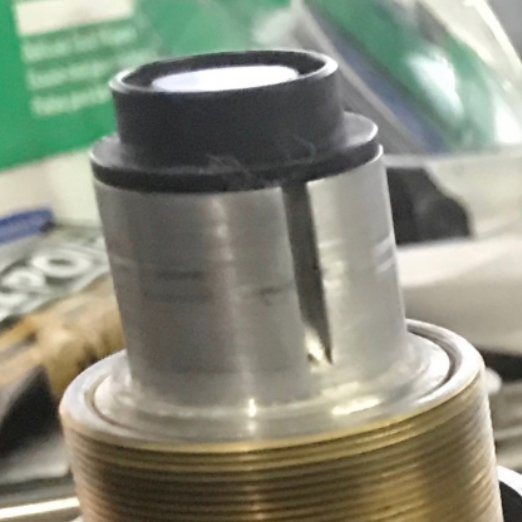-
Posts
46 -
Joined
-
Last visited
About Okto Simaia

Profile Information
-
Occupation
Student
-
Location
Houston TX
Recent Profile Visitors
The recent visitors block is disabled and is not being shown to other users.
-
Necroposting for future Googlers: the screw is almost certainly meant to ride in this channel, to keep the lens from rotating in the mount when focused. The most likely reason the lens wont budge when the screw is tightened down is that it's binding in this slot (either because it's the wrong size or is damaged). The test is to remove the screw and the mount and try to slide the screw in the slot with the mount removed. It should slide freely, but not too loosely. Too tight a fit, it will increase the force needed on the focus helical to move the optical block, too loose and the optical block will turn in the mount and the tip of the screw will bind (due to not being square to the slot) and have the same effect.
- 9 replies
-
- Repair
- Cine Lenses
-
(and 2 more)
Tagged with:
-
I know its look for stills, what I’m wanting to see is how it looks in motion. The pattern of grain from frame to frame is something that matters on motion picture film, where it doesn’t matter at all for stills.
-
Ah, a subject near and dear to my heart: how to shoot film and be a skinflint! 😛 the following advice is based on working with BW film; some of it may be applicable to color, some not You should definitely include benzotriazole (aka "reducer") in your development experiments. It will cut base fog without affecting the rest of the image too much. Many things written about it online, and also features in many older darkroom technique books. Develop cold. One of the things that happens to film as it ages is the grain gets bigger. More accurately, the grain clumps more, resulting in what we think of as "grain." Cold development reduces the formation of these clumps. Figure out how much you can overexpose to get the image out of the base fog without blocking up the highlights. Still film has the advantage that contrast and density can easily be tuned in the print, so you can get solid prints from even bad negs, but this is exponentially more effort to do with motion picture film. With reversal, you might not be able to get away with almost any over-exposure before you blow the highlights out. It's a look, but isn't always the right one. Get a still camera to do initial exposure and development tests. You'll waste less film, you can work with shorter lengths easily, and it's much easier (and more film-efficient) to bracket your exposures. Who wants to fuss with shooting just 40 frames of motion, let alone that much time loading and unloading magazines in the dark, not to mention how much film you'll waste on the head and tail of each clip? Bulk loader and any old 35mm SLR for 35mm, or a Kiev-30 or Mamiya 16 for 16mm. You'll need to load cartridges in a darkroom for the submini still cameras, but I imagine a school that still has piles of expired film stock likely has a darkroom If you'd like to collaborate on this, I'm happy to help any way I can. I am primarily a stills photographer, but I've got more or less a decade of darkroom experience and access to a very well-equipped darkroom. I'll DM you about it. Also, here's some info from folks who have been working with super-expired still film: How I removed base fog from old film stocks - DIY Photography TRI-X 74 - extremely-expired development experiments | Shaka1277
-
I was wondering if anyone had developed BW cine film in Rodinal and has a demo reel/example footage they could share? I love Rodinal for stills, and I'd like to see if that carries over into movies for me. I'm most interested in 16mm, since this is a hobby for me, but whatever you've got is still of interest.
-

Anyone need a Crystal Sync motor for Kinor 16CX cameras?
Okto Simaia replied to Aapo Lettinen's topic in Russian Gear
If only I could get my hands on a Kinor-16 to use it with. 😛 -
Thank you! I seem to have mixed up two different threads about the C16, I’m looking for the service manual, not the instruction manu.
-
Do you still have a copy of that manual? Shame no download link was provided.
-

Dimensioned drawings/blueprints of Krasnogorsk K-3/SP-16 bayonet?
Okto Simaia replied to Okto Simaia's topic in Russian Gear
To avoid duplicated effort, is my thought. Since the two mounts differ only in dimensions, it doesn't make a lot of sense to design a separate mount just to...keep amateurs from using pro lenses? It doesn't seem like there's anything to gain by modifying the SP16 mount (which IIRC came first). -

Dimensioned drawings/blueprints of Krasnogorsk K-3/SP-16 bayonet?
Okto Simaia replied to Okto Simaia's topic in Russian Gear
Thanks for the quick response. There’s some confusion on that, although certianly this is true for at least some lenses, since I own one that won’t mount on the Krasno. 😛 What I have been led to believe by RAF and Olex and The Soviet Camera Website Whose Name I Forget is that there were multiple SP-16 mounts, and that one of them is directly compatible, and one is not. Olex has said so explicitly on this site. The conflicting information (which I believe to be in good faith and coming from informed sources on all sides) is why I’m hoping to find reference documents to be able to put that uncertainty to bed. -

USED BOLEX H16 REX-5 S16 FILM CAMERA (MODIFIED) FOR SALE
Okto Simaia replied to Roberto Checa's topic in Cine Marketplace
A Bolex for the price of four Arris. What a bargain!





